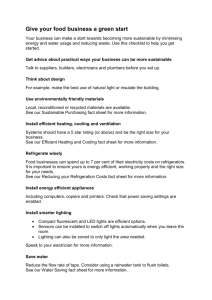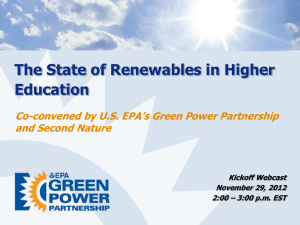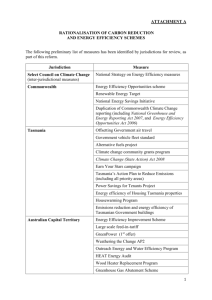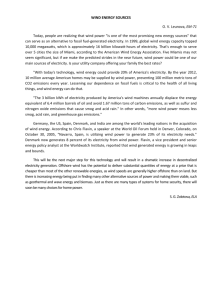Tim Kelly - GreenPower
advertisement
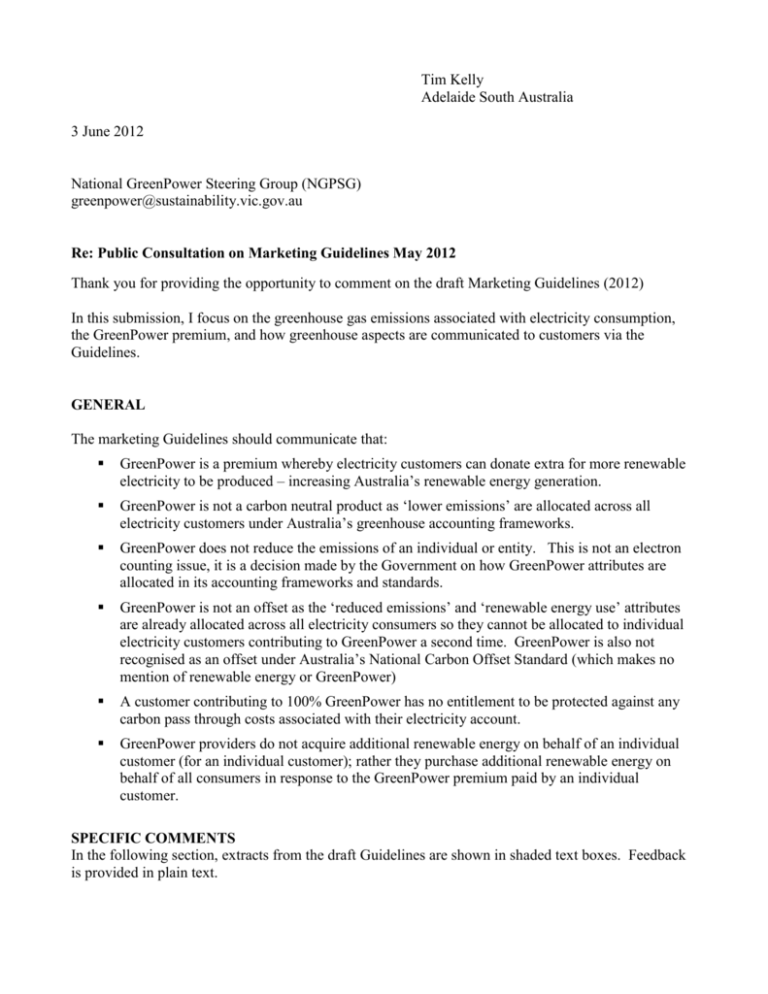
Tim Kelly Adelaide South Australia 3 June 2012 National GreenPower Steering Group (NGPSG) greenpower@sustainability.vic.gov.au Re: Public Consultation on Marketing Guidelines May 2012 Thank you for providing the opportunity to comment on the draft Marketing Guidelines (2012) In this submission, I focus on the greenhouse gas emissions associated with electricity consumption, the GreenPower premium, and how greenhouse aspects are communicated to customers via the Guidelines. GENERAL The marketing Guidelines should communicate that: GreenPower is a premium whereby electricity customers can donate extra for more renewable electricity to be produced – increasing Australia’s renewable energy generation. GreenPower is not a carbon neutral product as ‘lower emissions’ are allocated across all electricity customers under Australia’s greenhouse accounting frameworks. GreenPower does not reduce the emissions of an individual or entity. This is not an electron counting issue, it is a decision made by the Government on how GreenPower attributes are allocated in its accounting frameworks and standards. GreenPower is not an offset as the ‘reduced emissions’ and ‘renewable energy use’ attributes are already allocated across all electricity consumers so they cannot be allocated to individual electricity customers contributing to GreenPower a second time. GreenPower is also not recognised as an offset under Australia’s National Carbon Offset Standard (which makes no mention of renewable energy or GreenPower) A customer contributing to 100% GreenPower has no entitlement to be protected against any carbon pass through costs associated with their electricity account. GreenPower providers do not acquire additional renewable energy on behalf of an individual customer (for an individual customer); rather they purchase additional renewable energy on behalf of all consumers in response to the GreenPower premium paid by an individual customer. SPECIFIC COMMENTS In the following section, extracts from the draft Guidelines are shown in shaded text boxes. Feedback is provided in plain text. 2.2 RULES ON WHAT LANGUAGE CAN BE USED TO DESCRIBE GREENPOWER ACCREDITED PRODUCTS 6 All carbon related claims are to be in accordance with the Australian Consumer Law – part of the Competition and Consumer Act 2010 (Cth) (the Act), and the latest guidelines and publications published by the ACCC. The GreenPower Marketing Manager will provide links on the GreenPower website under the Business Centre Section, to ensure the information is clear, relevant, and easily accessible. The latest ACCC Guidelines do not provide clarity relating to GreenPower with respect to carbon emissions and carbon price exposure. The ACCC guidelines are currently targeted towards businesses making claims beyond their carbon exposure. In the case of GreenPower however the situation is that customers do have carbon liabilities that they may be unaware of because of marketing which suggests that their emissions are low or zero. 7 Statements relating to a carbon price must meet the requirements of the ACCC “Carbon Price Claims” including but not limited to: 7.1 Claims must not wrongly suggest that the carbon price will affect the price of Provider’s product or services prior to 1 July 2012. Section 7.1 is not relevant to the GreenPower situation. GreenPower customers need to know that their emissions are not zero and are rightly subject to carbon pass through costs under current frameworks. 7.2 Claims must not wrongly suggest that the carbon price has directly affected the price of the GreenPower accredited portion of the product (even though it may or may not affect the unaccredited portion of the product sold to a GreenPower customer and, therefore, the overall package price). Section 7.2 is misleading. The GreenPower accredited portion is a donation or a premium. GreenPower is not a true product as such and therefore cannot be subject to a carbon price. The electricity component is however fully subject to a carbon price. The entire electricity component is unaccredited. 7.3 Claims must not wrongly suggest that price increases due to other circumstances are attributable to a carbon price. Agreed 7.4 Where the grid electricity component of the product includes a carbon price, this must as a minimum be communicated to the customer when requested. Statements relating the grid electricity component of the product which includes a carbon price must be free from false, deceptive or misleading claims and: The Guidelines must clarify that the electricity component is always 100% of the electricity provided. It must communicate that 100% of every electricity account is subject to carbon pricing. The wording is confusing as it could suggest that there may be a proportion of the electricity component that is less than 100% which is not possible. As a start, it is welcome that the Guidelines require carbon pricing to be communicated to GreenPower customers on request. However, any carbon pricing applied to a GreenPower account should be communicated to these customers at all times, not simply on request. Keep in mind that the popular perception created by GreenPower over many years is that 100% GreenPower contributing customers have no emissions associated with their electricity use. These customers deserve clarity and transparency in relation to their electricity accounts at all times 7.4.1 Specify that it is only the grid electricity component of the product that attracts a carbon price The marketing Guidelines should specify that: 100% of the electricity provided attracts a carbon price (regardless of whether retailers actually charge this carbon price). The GreenPower donation or premium does not attract a carbon price. 7.4.2 Briefly explain the distinction between the GreenPower premium and the grid electricity component of the product or refer the customer to the GreenPower website for assistance The Guidelines do not make it clear that the grid electricity component is always 100% of electricity use, and that the donation or premium is simply to drive additional renewable electricity for all customers. 8 Statements relating to greenhouse gas emission reductions must meet the following requirements: 8.1 Individuals and entities: - An individual or entity may claim to have reduced its own emissions associated with the generation of electricity through the purchase of GreenPower. The above statement (section 8.1) is false. Australia’s NGER legislation, key greenhouse accounting frameworks and standards simply do no not support this concept. Indeed the NGER Determination (Chapter 7) does not permit this approach and National Greenhouse Accounts (NGA) includes all renewables within the factors, such that the ‘reduced emissions’ attribute has already been allocated across all electricity customers. GreenPower publications and this proposed guideline should not promote concepts that are not covered by legislation or standard. The Guidelines can instead promote that when individuals or entities support GreenPower they are: Driving additional renewable energy generation Reducing Australia’s emissions Reducing the emissions of all customers rather than reducing their own individual greenhouse gas emissions An individual should not be referred to as an “it” Suggest using the word ‘their’. 8.2 Aggregate level: - Any claim made in relation to GreenPower’s role in reducing Australia’s emissions must adequately explain that this can only be achieved through the retirement of AAUs under the Kyoto Protocol. The GreenPower marketing advice should not be so specific until the Federal Government finalises its arrangements for retiring AAUs and reducing the availability of permits to preserve the greenhouse reductions of GreenPower in the national context. The retirement of AAUs is not the likely to be the only way to reduce emissions nationally. Why have actions in non covered sectors if not to reduce emissions? It is also arguable that if everyone is voluntarily more efficient and switches to lower emissions goods and services, that this makes it easier for the Federal Government to tighten Australia’s national target and scheme caps through time –faster than carbon pricing acting alone). It is suggested that the Marketing Guidelines simply state that the Federal Government has committed to ensuring that Australia’s National Target and scheme caps are progressively tightened to reflect GreenPower sales. 9 Any claim of environmental benefit must be backed by sound research and clarity of what those benefits are to avoid misleading consumers. Agreed I trust that these comments can assist in providing greater clarity for GreenPower contributing customers. Kind regards Tim Kelly

